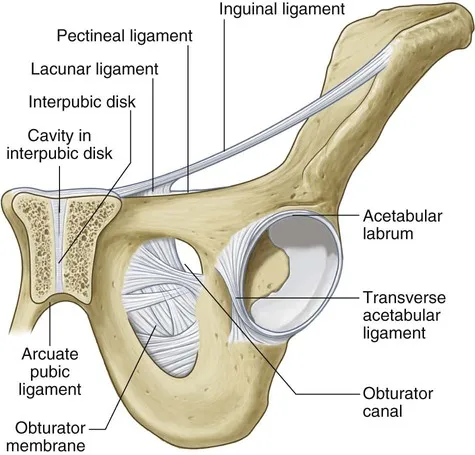pelvic ligaments and fascia
1/12
There's no tags or description
Looks like no tags are added yet.
Name | Mastery | Learn | Test | Matching | Spaced |
|---|
No study sessions yet.
13 Terms
sacrospinous ligament
attachment points: ischial spine to sacrum
fiber direction: M to L, P to A
associated structures/function: limits movement of pelvis and sacrum, converts greater and lesser sciatic notches into G/L foramen
sacrotuberous ligament
attachment points: ischial tuberosity to lateral borders of sacrum and coccyx
fiber direction: M to L, S to I, O, P to A
associated structures/function: stabilize pelvis and sacrum, limit movement, converts greater and lesser sciatic notches into G/L foramen
inguinal ligament
attachment points: ASIS to pubic tubercle
fiber direction: M to L, S to I
associated structures/function: prevents excessive movement, support, attaches external oblique muscles to pelvis, forms boundary of femoral triangle and inguinal canal
iliolumbar ligament
attachment points: lateral tip of transverse processes of L5 and L4 to superior aspect of the iliac crest and iliac fossa
fiber direction: M to L, with an upper band and lower band
associated structures/function: stabilizes sacroiliac joint, strengthens lumbosacral joint, supports mobility, limits range of motion through lumbosacral junction
posterior sacroiliac ligament
attachment points: lateral crest of sacrum to the iliac crest (superficial to other supporting ligament on sacrum)
fiber direction: nearly horizontal
associated structures/function: provide reinforcement of joint of sacroiliac joint, pelvic stability by limiting the displacement of the ilium from the sacrum
anterior sacroiliac ligament
attachment points: lateral aspect of the ilium to the third sacral segment
fiber direction: nearly horizontal
associated structures/function: reinforces joint, thickens joint capsule
interosseous sacroiliac ligament
attachment points: deep to the posterior sacroiliac ligament
fiber direction: nearly horizontal
associated structures/function: prevent anterior/posterior movement of the sacrum, prevents abduction or destruction of the sacroiliac joint
*STRONGEST LIGAMENT IN THE BODY
lacunar ligament
attachment points: pubic tubercle and superior pubic ramus
fiber direction: posteriorly and attach to pectineal line
associated structures/function: fibers of inguinal ligament and fascia lata

pectineal ligament
attachment points: extension of lacunar ligament, runs on pectineal line of pubic bone
fiber direction:
associated structures/function: runs along pubis along superior ramus, highly resistant

conjoint tendon/inguinal aponeurotic falx
attachment points: runs along pectineal line
fiber direction:
associated structures/function: transversalis abdominis, and internal oblique muscle - adds strength to medial aspect of posterior inguinal canal wall
linea alba
attachment points: xiphoid process to pubic symphysis
fiber direction: spans A/P midline of the abdomen
associated structures/function: connection point for most abdominal musculature
fascia transversalis.
attachment points: between abdominal wall muscles and peritoneum cavity
fiber direction: A/P
associated structures/function: separate the abdominal wall from peritoneum
rectus sheath fascia
attachment points: formed by aponeurosis of transverse abdominal and I/E oblique muscles
fiber direction:
associated structures/function: encloses rectus abdominis and pyramidalis muscles, protects muscles and vessels it encloses, support to abdominal viscera